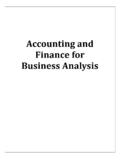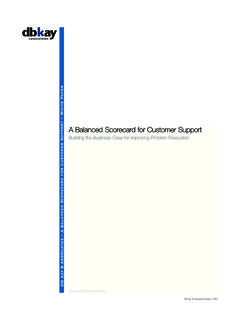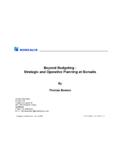Transcription of Strategic-Based Control - Apex CPE
1 The balanced scorecard : Strategic-Based Control The balanced scorecard : Strategic-Based Control Copyright 2014 by DELTACPE LLC All rights reserved. No part of this course may be reproduced in any form or by any means, without permission in writing from the publisher. The author is not engaged by this text or any accompanying lecture or electronic media in the rendering of legal, tax, accounting, or similar professional services. While the legal, tax, and accounting issues discussed in this material have been reviewed with sources believed to be reliable, concepts discussed can be affected by changes in the law or in the interpretation of such laws since this text was printed. For that reason, the accuracy and completeness of this information and the author's opinions based thereon cannot be guaranteed.
2 In addition, state or local tax laws and procedural rules may have a material impact on the general discussion. As a result, the strategies suggested may not be suitable for every individual. Before taking any action, all references and citations should be checked and updated accordingly. This publication is designed to provide accurate and authoritative information in regard to the subject matter covered. It is sold with the understanding that the publisher is not engaged in rendering legal, accounting, or other professional service. If legal advice or other expert advice is required, the services of a competent professional person should be sought. -From a Declaration of Principles jointly adopted by a committee of the American Bar Association and a Committee of Publishers and Associations.
3 All numerical values in this course are examples subject to change. The current values may vary and may not be valid in the present economic environment. Course Description The balanced scorecard (BSC) is a Strategic-Based responsibility accounting system that converts an organization s mission and strategy into operational objectives and measures for four perspectives: the financial perspective, the customer perspective, the internal process perspective, and the learning and growth perspective. The course addresses the main features of the balanced scorecard and its implementation. Presented are several notable case studies that implemented and applied the BSC. Field of Study Accounting Level of Knowledge Overview Prerequisite None Advanced Preparation None Table of Contents The balanced scorecard : Strategic-Based Control .
4 1 Learning Objectives ..1 Activity- based Versus Strategic-Based Responsibility Accounting ..2 Assigning Responsibility ..2 Establishing Performance Metrics ..3 KPIs and Evaluation ..3 Assigning Rewards ..3 Basic Concepts of the balanced scorecard ..3 Financial Perspective: Objectives and Customer Perspective: Objectives and Measures ..8 Review Questions Section 1 .. 10 Internal business process Perspective: Objectives and KPIs .. 12 Learning and Growth Perspective: Objectives and KPIs .. 15 scorecard for a Biotechnology Firm .. 18 Applying the balanced scorecard to a School District .. 19 scorecard for a Consumer Products Firm .. 20 The balanced scorecard and United Parcel Service .. 21 balanced scorecard and Nonprofits .. 21 Web Resources .. 22 strategic Alignment.
5 22 Linking KPIs to Strategy .. 23 Sustainability and Performance 25 Implementing a balanced scorecard .. 25 Case Studies .. 26 Case study 1: Mobil Corporation .. 26 Case Study 2: Tesco .. 34 Case Study 3: Toyota .. 42 Case Study 4 - International Baccalaureate .. 46 Review Questions Section 2 .. 50 Glossary .. 51 Index .. 52 Review Question Answers .. 53 1 The balanced scorecard : Strategic-Based Control Learning Objectives After studying this course you will be able to: 1. Recognize key attributes of a Strategic-Based responsibility accounting systems. 2. Identify the basic characteristics and outcome measurements of the balanced scorecard . 3. Identify operational objectives and Key Performance Indicators (KPIs) for each perspective. 4. Recognize how the balanced scorecard links measures to strategy.
6 5. Calculate key performance indicators. In today s world there is no need to say that competitive edge cannot be gained only by excellent management of physical and financial assets. The ability of a company to mobilize and exploit its tangible or invisible assets has become far more decisive than investing and managing physical, tangible assets. In other words, the success of a company no longer depends upon production facilities, financial capital and ownership, but more upon intangible assets. Intangible assets are defined as the assets that are not physical in nature such as intellectual property, trade secrets, pricing formulas, customer lists, business plans, recipes, and so on. Intangible assets are of great importance because they enable a company to distinguish itself from competitors by: Developing customer relationships that retain the loyalty of existing customers; Introducing innovative products and services desired by targeted customer segments; Producing customized high-quality products and services at low cost and with short lead times; Mobilizing employee skills and motivation for continuous improvements in process capabilities, quality, and response times; Deploying information technology, data bases, and systems By taking the importance of intangible assets, it makes much more sense to say that these traditional financial systems should be expanded to incorporate the valuation of a company s intangible assets.
7 And right at this point, a model developed by Robert S. Kaplan and David P. Norton comes into scene, the balanced scorecard . The balanced scorecard (BSC) is a strategic performance management system that permits an organization to create a strategic focus by translating an organization's strategy into operational objectives and performance measures for four different perspectives: the financial perspective, the customer perspective, the internal 2 business process perspective, and the learning and growth (infrastructure) perspective. A strategic performance management system can assume different forms, the most common being that of the balanced scorecard . Strategy is defined as choosing the market and customer segments the business unit intends to serve, identifying the critical internal and business processes that the unit must excel at to deliver the value propositions to customers in the targeted market segments, and selecting the individual and organizational capabilities required for the internal, customer, and financial objectives.
8 Activity- based Versus Strategic-Based Responsibility Accounting Activity- based responsibility accounting represents a significant change in how responsibility is assigned, measured, and evaluated. The activity- based system added a process perspective to the financial perspective of the functional- based accounting system. In effect, responsibility accounting changed from a one-dimensional system to a two-dimensional system and from a Control system to a performance management system. The responsibility accounting model is defined by four essential elements: 1. Assigning responsibility 2. Establishing performance measures or benchmarks 3. Evaluating performance 4. Assigning rewards. Continuous improvement (CI) efforts associated with responsibility accounting in an activity- based environment are often fragmented and they fail to connect with the organization s overall mission and strategy.
9 Directed continuous improvement requires managers to carefully specify a mission and strategy for their organization and identify the objectives, performance measures, and initiatives necessary to accomplish this overall mission and strategy. Assigning Responsibility Effective management Control requires performance measurement and feedback. This process affects allocation of resources to organizational subunits. It also affects decisions about managers' compensation, advancement, and future assignments. Furthermore, evaluating their performance serves to motivate managers to optimize the measures in the performance evaluation model. However, that model may be inconsistent with the organization's model for managerial decision making. The Strategic-Based responsibility accounting system adds direction to improvement efforts by tying responsibility to the firm s strategy.
10 Ideally, all individuals in the organization should understand the organization s strategy and know how their specific responsibilities support achievement of the strategy. 3 Establishing Performance Metrics With the Strategic-Based approach, performance measures or key performance Indicators, KPI for short) must be integrated so that they are mutually consistent and reinforcing. The performance measures must be balanced and linked to the organization s strategy. When the measures selected are balanced between lag measures and lead measures, between objective measures and subjective measures, between financial measures and nonfinancial measures, and between external measures and internal measures, the KPIs are considered to be balanced . Lag measures are outcome measures or measures of results from past efforts ( , customer profitability).















